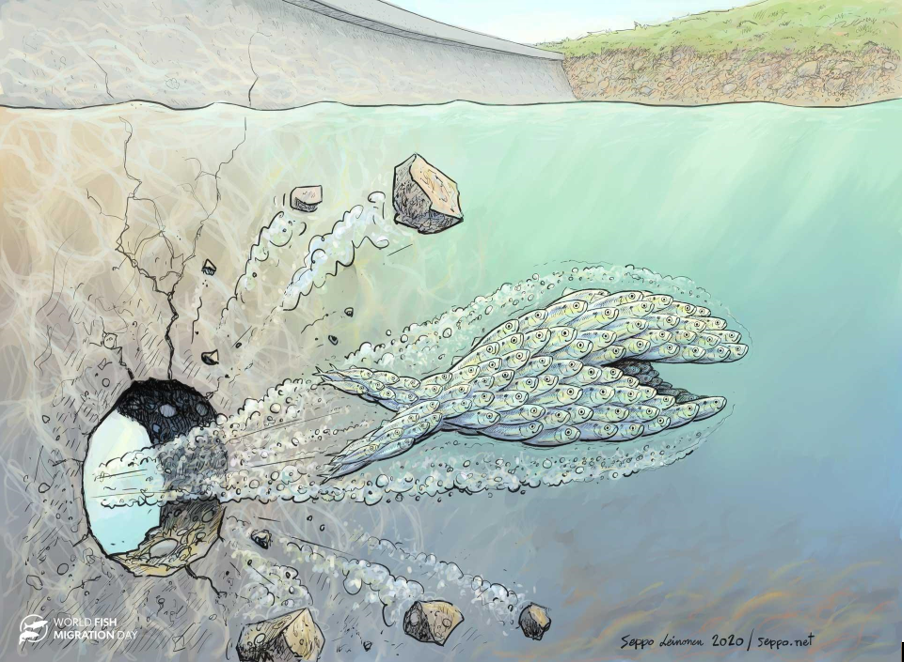On World Fish Migration Day, Dr Laura Gutiérrez reflects on eel’s charisma, consumption and human practices that affect the wellbeing of this migratory fish species.

This year we celebrate World Fish Migration Day, which takes place every two years and aims to raise awareness of migratory fish species and the waterways on which they rely in order to make their life-cycle journeys. This year’s theme is ‘Breaking Free’. Now, after a couple of years of lockdowns, we can all relate to the urgency with which we—both human and non-human animals—seek to move freely in healthy, safe environments. A great number of fish species have been put under tremendous pressure by human-made barriers that block their migratory waterways. This restriction of their movement threatens the flourishing—and in some cases the very survival—of these species. The European eel is among the fish species that have been seriously affected by this problem. Today, then, we will take part in World Fish Migration Day by talking a little bit about the research we at the Beastly Business Project are currently undertaking on this migratory fish.
Eels are a fascinating species. They may lack the instant appeal of some of the more photogenic of the endangered groups—the cute and cuddly looks of the red panda, say—but you need only speak with anyone who is interested in eels to realise that this species has the power to enthral to the point of obsession with its perplexing life-cycle and biological traits. Eels spawn in the Sargasso Sea, then head to coastal waters and estuaries before arriving at rivers, where they grow for several years before returning to the ocean to complete their life-cycle. Their reproduction process is complex and has yet to be successfully replicated in a controlled setting, which means that every eel we come into contact with—whether in a river or on your plate—has come from the wild. For this reason, every threat to their environment and wellbeing has serious repercussions for the overall survival of the species.
The European eel—the species which we study at Beastly Business—is endangered and has therefore been listed in CITES Appendix II. It is estimated that current number of fish stocks are between 1% and 10% of pre-1980s numbers. At Beastly Business we set out to explore the overlap between legal and illegal endeavours related to the European eel trade. The key driver of this trade is tied to a great demand for eels in China (with Japan as final destination for consumption). The handsome price paid per kilogram of very young eels (called glass eels) is often hard to resist for those seeking profit and comfortable disregarding the illegality of their activities. Trafficking of European eels is done in several ways. From transporting tiny eels in plastic bags in airplane luggage, to concealing them in mislabelled cargo containers, human ingenuity continues to find ways to illegally trade in this endangered species.
In the first year of the project I have interviewed a variety of stakeholders, including eel fishers, scientists, law-enforcement officers, members of environmental organisations and institutions, EU officials, and industry representatives. The data collected from these experts has revealed an extremely complex picture, and it has become clear that the road to population recovery is long and fraught with pitfalls. Among the issues is the fact that regulation of the catching and trading of European eels is not easy, as it involves various legal loopholes, grey areas and difficult-to-police practices. For instance, trade within the European Union is allowed but taking European eels outside this area is not permitted. The fact that there are legal ways to catch and trade in this species within the EU means that—unlike trade in commodities that are largely prohibited, such as cocaine—the lines separating legal and illegal trade are fairly porous. It is incredibly challenging for the authorities to establish whether European eels that are being transported across EU member states are destined for consumption within the EU or if they are making their way to ‘easy’—i.e. lightly policed—borders, through which they can take the animals to non-EU destinations. At Beastly Business we are shedding light on this complex intersection of legality and illegality in the hope of better informing policy and conservation strategies.
In addition to this focus on legal/illegal trade, it is imperative that we acknowledge that trafficking for consumption purposes is not the only reason why the species is under pressure. As highlighted by the World Fish Migration Day agenda, there are several other human practices that seriously affect fish like the European eel. Blocking of migratory waterways, habitat loss, dumping of pollutants in bodies of water, and an assortment of climate-change-related conditions that are harder to pinpoint, are all contributors to this current strain on the species. If we want to ensure the survival and wellbeing of migratory fish species, we must endeavour to remove all these barriers (physical and otherwise) that prevent them from thriving in their natural environments.
We encourage you to explore the hundreds of events that will take place around the globe in the next year to celebrate migratory fish and learn how we can better protect them and ensure that they continue to enrich our waters.
